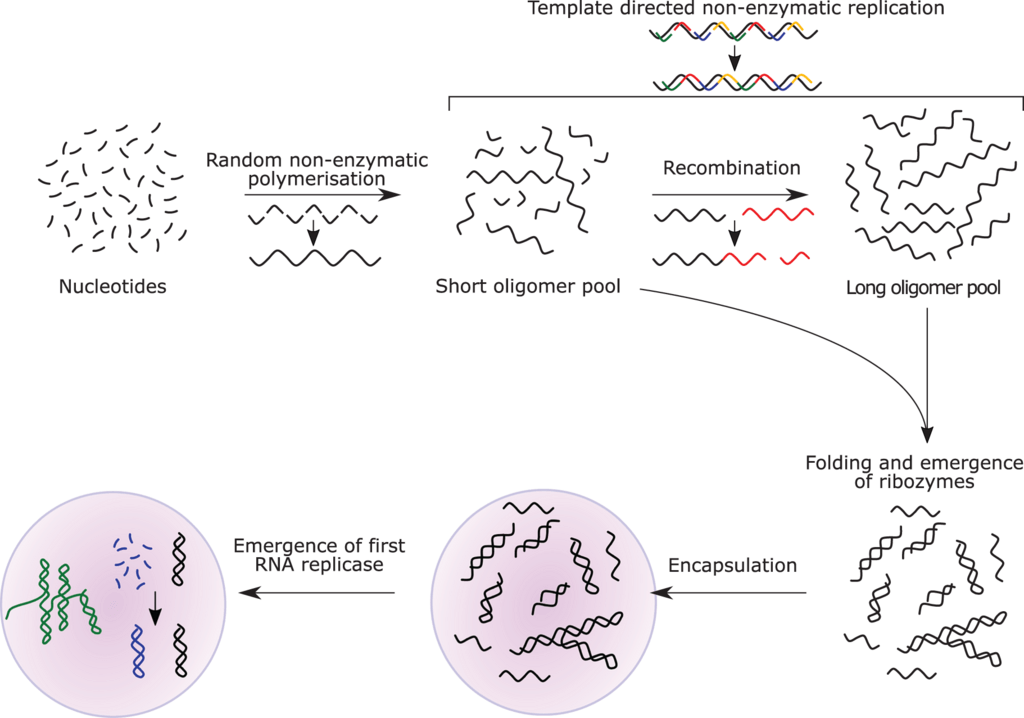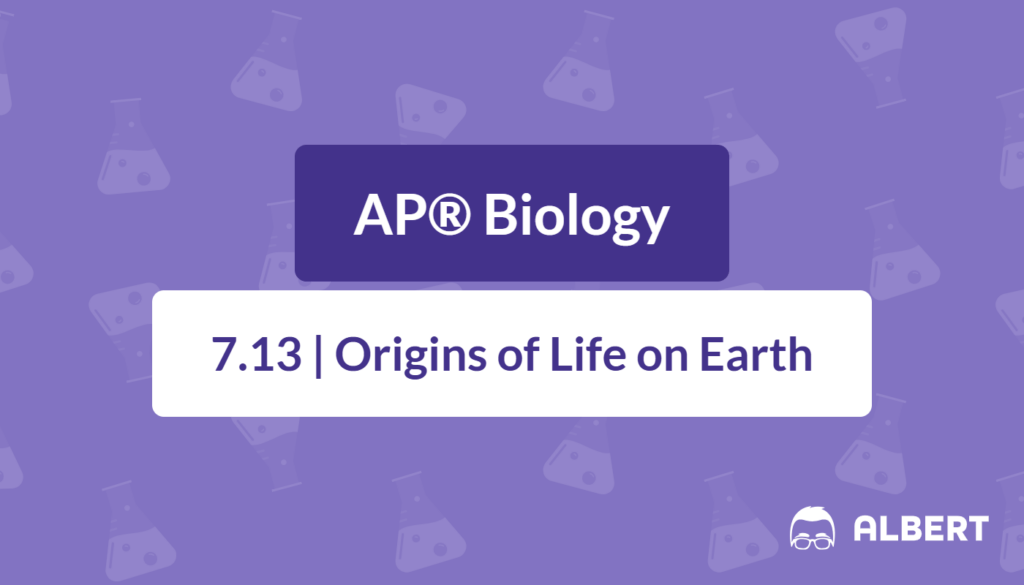Understanding how life began on Earth is a key topic in biology. This question has fascinated scientists for generations. Today, there are several origin of life theories that combine geological evidence, chemical experiments, and the idea of an “RNA World.” The following sections simplify these concepts step by step.
What We Review
Introduction
The origin of life deals with how the first living organisms formed from non-living matter. Researchers have proposed different scenarios based on evidence from Earth’s ancient rocks and lab experiments. Although many details remain under investigation, there is firm support for these theories coming from fossil evidence and chemical data.
In this review, the focus is on major events that shaped life on Earth. These include the shift from a harsh environment to one supporting simple life forms, then the appearance of more complex organisms. By examining these steps, students can grasp how life evolved from tiny molecules into the world we see today.
Understanding the Concept of the Origin of Life
The phrase “origin of life” refers to the process by which simple chemical compounds combined to form more complex structures that eventually became living cells. This topic is significant because it shows how small changes in chemistry and the environment can lead to self-sustaining biological systems.
- Scientists study how early Earth conditions, such as volcanic activity and ultraviolet (UV) radiation, might have helped form the building blocks of life.
- This framework connects geology, biology, and chemistry, guiding our understanding of life’s evolution.
Example: Why This Matters
Imagine trying to assemble a puzzle without seeing the final picture. Early Earth conditions are like the puzzle’s border pieces. They give us a starting point. Once those border pieces are in place, it becomes easier to see how the other pieces fit, showing life’s big picture.
Step-by-step:
- Identify the conditions on early Earth (hot temperatures, volcanic gases).
- Determine which compounds are present in those conditions (e.g., H_2O, CH_4, NH_3).
- Propose how these compounds might combine under harsh environments.
- Evaluate whether any resulting molecules could perform basic life functions.
Geological Evidence Supporting the Origin of Life
A. Earth’s Timeline
Research suggests Earth is about 4.6 billion years old (4.6 \text{ bya}). Before 3.9 \text{ bya}, our planet’s environment was hostile, with intense volcanic activity and frequent meteor strikes. Despite this, the earliest fossil evidence of life appears around 3.5 \text{ bya}. These early fossils reveal simple, single-celled organisms that left behind stromatolites—layered structures formed by microbial activity.
- By studying these fossils, scientists confirm that life existed at least 3.5 billion years ago.
- Rocks from this period often contain chemical traces hinting at living processes.
Example: The Great Oxygenation Event
The Great Oxygenation Event was a major turning point in Earth’s atmosphere.
- Early Earth’s atmosphere contained little oxygen.
- Tiny organisms called cyanobacteria used sunlight to convert CO_2 and water into sugar and O_2.
- Over time, oxygen built up in the atmosphere.
- This change allowed more complex life to develop, but it also caused some early anaerobic species to die out or adapt.
This event shows how life can shape its environment, helping us understand how tiny single-celled organisms had a massive impact on Earth’s future.
Theories of the Origin of Life
There are several theories about the origin of life. Some suggest life formed spontaneously from Earth’s natural chemical processes, whereas others consider external sources. Despite their differences, each theory tries to explain how inorganic building blocks became organic molecules—and eventually living cells.
A. Primitive Earth Theory
This view suggests that early Earth’s conditions favored the formation of organic molecules from simple inorganic compounds. Intense lightning, UV radiation, and volcanic eruptions likely provided the energy needed for these reactions.
Example: Stanley Miller’s Experiment
Stanley Miller tested how amino acids—the basic building blocks of proteins—might have formed on early Earth. His experiment is one of the most famous chemical experiments related to the origin of life theories.
Step-by-step breakdown:
- A closed apparatus was set up with water (H_2O) and gases such as methane (CH_4), ammonia (NH_3), and hydrogen (H_2).
- Water was heated to produce vapor.
- Electric sparks substituted for lightning, providing energy.
- After several days, simple organic molecules, including amino acids, were detected in the solution.
This experiment showed that organic building blocks can form from inorganic materials under conditions similar to those on primitive Earth.
B. Extraterrestrial Hypothesis
Another theory proposes that life’s building blocks might have arrived from space. Meteorites sometimes carry organic molecules, including amino acids. Such discoveries hint that extraterrestrial objects could have delivered these life-forming compounds, seeding Earth with the material necessary to form simple organisms.
Example: Organic Molecules in Meteorites
Scientists examined meteorite fragments found around the world:
- Samples revealed amino acids similar to those in living organisms.
- Analysis showed these amino acids formed naturally in outer space.
- This supports the idea that essential compounds might have come from beyond Earth.
Chemical Experiments Supporting the Origin of Life
After basic organic molecules formed, they needed to combine into larger structures. These larger structures, known as polymers, can store energy and information—a crucial step in building living cells. In these chemical experiments, scientists explore how monomers (small repeating units) connect to form polymers (long chains).
- Monomers: simple molecules like amino acids or nucleotides.
- Polymers: chains of repeating monomers, such as proteins or nucleic acids.
Example: Polymerization Process
A simplified step-by-step illustration of how polymers might form:
- Start with monomers in a solution.
- Provide a source of energy (e.g., heat from volcanic activity).
- Monomers connect, forming a small chain (a dimer or trimer).
- These chains then grow longer, creating proteins or RNA-like molecules.
- Under the right conditions, some polymers fold into structures with specific functions (e.g., catalysts).
This process highlights how random chemical reactions could eventually produce complex, life-related molecules.
The RNA World Hypothesis
Many scientists think RNA was the first genetic material. This idea is known as the “RNA World Hypothesis.” RNA can store genetic information, similar to DNA, and can also catalyze chemical reactions. Because of this dual ability, RNA might have kick-started life before DNA and proteins became dominant.

Example: RNA’s Functions in Early Life
RNA has unique features that support the RNA World Hypothesis:
- RNA replication: Some RNA molecules can copy themselves under specific conditions.
- Catalytic power: RNA enzymes, called ribozymes, can speed up chemical reactions.
- Information storage: RNA can carry information that passes from one “generation” of molecules to the next.
These qualities suggest that primitive RNA could have undergone continual replication and evolution, eventually leading to more stable systems involving DNA and proteins.
Summary of Key Theories and Evidence
- Geological evidence shows Earth is approximately 4.6 billion years old, with the earliest fossil evidence dated to around 3.5 \text{ bya}.
- The Great Oxygenation Event reveals how microbial life can change an entire atmosphere.
- The Primitive Earth theory explores how conditions on early Earth could produce amino acids and other molecules.
- The extraterrestrial hypothesis proposes that organic molecules arrived on meteorites.
- Chemical experiments demonstrate how monomers can form polymers through polymerization.
- The RNA World Hypothesis highlights RNA’s potential role as both a catalyst and an information carrier.
These findings combine to explain the fascinating journey from simple inorganic materials to the earliest fossil evidence of life on Earth.
VII. Key Vocabulary and Definitions
| Term | Definition or Key Feature |
| Origin of Life Theories | Various proposals about how life arose from non-living matter |
| Geological Evidence | Rock and fossil records showing Earth’s timeline and early life indicators |
| Early Fossil Evidence | Remnants of ancient microorganisms, typically around 3.5 billion years old |
| Great Oxygenation Event | Period when oxygen levels in the atmosphere increased due to cyanobacteria |
| Stanley Miller’s Experiment | Lab test demonstrating amino acid formation from simple gases and sparks |
| Extraterrestrial Hypothesis | Idea that organic molecules arrived on Earth via meteorites or comets |
| Monomers and Polymers | Simple building blocks (monomers) that link to form long chains (polymers) |
| Polymerization | Process in which monomers chemically bond to form large molecules |
| RNA World Hypothesis | Proposal that RNA was Earth’s first genetic material, predating DNA |
| RNA Replication | The process by which RNA makes copies of itself under the right conditions |
Conclusion
The study of life’s origins connects biology, chemistry, and geology to reveal how simple molecules could form complex, self-sustaining systems. Understanding these processes explains why Earth’s environment changed over time, ultimately allowing diverse life forms to flourish. Although many questions remain, investigating the early fossil evidence, conducting chemical experiments, and exploring the RNA World Hypothesis all bring us closer to understanding life’s first steps.
Scientists continue to refine these origin of life theories, drawing on new discoveries in space exploration and molecular biology. Asking questions and exploring further is encouraged, as new insights may rewrite our understanding of life’s beginnings on Earth.
Sharpen Your Skills for AP® Biology
Are you preparing for the AP® Biology test? We’ve got you covered! Try our review articles designed to help you confidently tackle real-world math problems. You’ll find everything you need to succeed, from quick tips to detailed strategies. Start exploring now!
Need help preparing for your AP® Biology exam?
Albert has hundreds of AP® Biology practice questions, free response, and full-length practice tests to try out.








